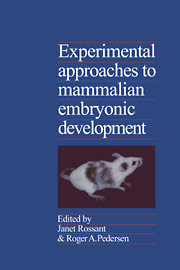Book contents
- Frontmatter
- Contents
- Preface
- Contributors
- Cellular aspects
- Molecular and biochemical aspects
- Toward a genetic understanding of development
- 13 Evidences and consequences of differences between maternal and paternal genomes during embryogenesis in the mouse
- 14 Mutations and chromosomal abnormalities: How are they useful for studying genetic control of early mammalian development?
- 15 Production of permanent cell lines from early embryos and their use in studying developmental problems
- 16 Integration and expression of genes introduced into mouse embryos
- Index
14 - Mutations and chromosomal abnormalities: How are they useful for studying genetic control of early mammalian development?
from Toward a genetic understanding of development
Published online by Cambridge University Press: 31 March 2010
- Frontmatter
- Contents
- Preface
- Contributors
- Cellular aspects
- Molecular and biochemical aspects
- Toward a genetic understanding of development
- 13 Evidences and consequences of differences between maternal and paternal genomes during embryogenesis in the mouse
- 14 Mutations and chromosomal abnormalities: How are they useful for studying genetic control of early mammalian development?
- 15 Production of permanent cell lines from early embryos and their use in studying developmental problems
- 16 Integration and expression of genes introduced into mouse embryos
- Index
Summary
Introduction
The overall picture of mammalian development is one of complex but integrated molecular activity. The result of such activity is that cells of the embryo become distinguishable from one another, and by expressing certain features of a differentiated phenotype, they cooperate in morphogenetic interactions to form tissues. There is no doubt that gene activity is necessary for this process to occur. Experimental evidence in the mouse clearly indicates that suppression of transcription or expression of zygotic lethal mutations can halt development at practically any time, even as early as the 2-cell stage, as reviewed by Johnson (1981) and Magnuson and Epstein (1981). Nevertheless, the complexity of genomic organization and the roles of specific genes concerned with mechanisms of mammalian development and differentiation are matters of paramount importance that have yet to be unraveled.
Recent spectacular advances in molecular genetics have opened new prospects for studying the structure, organization, and regulation of gene expression in eukaryotes. In organisms such as Drosophila, these techniques, coupled with classic genetics, have provided a means by which one can identify and study genes that are necessary for control of normal development and differentiation. For example, it has been possible to identify and clone the homeotic genes of Drosophila, in the absence of any biochemical information about their products, because of the fact that multiple alleles and appropriate deletions and/or inversions are available and provide recognizable chromosomal breakpoints surrounding the mutant gene.
- Type
- Chapter
- Information
- Experimental Approaches to Mammalian Embryonic Development , pp. 437 - 474Publisher: Cambridge University PressPrint publication year: 1987
- 2
- Cited by



